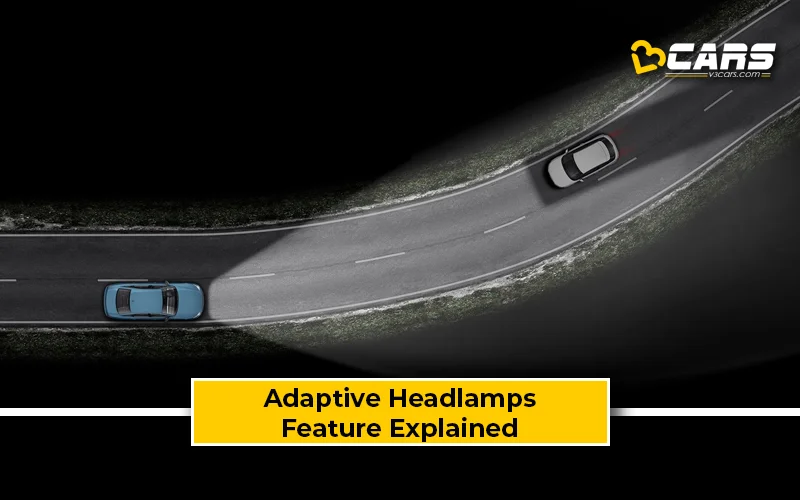
What Are Adaptive Headlamps?
Adaptive headlamps are advanced headlight systems that can automatically adjust their direction and sometimes even their intensity and beam pattern based on steering input, vehicle speed, and road conditions. Unlike fixed headlights, which always point straight ahead, adaptive systems “look” around corners and adapt to provide optimal illumination where it’s most needed.
How Do Adaptive Headlamps Work?
Adaptive Headlamps utilise a combination of sensors and motorised components to achieve their dynamic lighting capabilities:
- Steering Angle Sensors: These sensors detect how much the driver is turning the steering wheel. As the driver steers into a curve, the headlamps pivot in the direction of the turn, illuminating the road ahead around the bend before the car fully enters it.
- Vehicle Speed Sensors: The system uses vehicle speed data to determine how far ahead the light needs to be cast. At higher speeds, the beam might be longer and narrower, while at lower speeds (city driving), it might be wider and shorter to illuminate sidewalks and immediate surroundings.
- Yaw Rate Sensors: These sensors detect the vehicle’s rotational movement, helping the system understand the sharpness of a turn.
- Motorised Pivoting Mechanisms: Small electric motors within the headlamp assembly physically swivel the projector lenses (or the entire headlamp unit) horizontally and sometimes vertically.
- Advanced Systems (Matrix/Pixel LED): More sophisticated adaptive systems, like Matrix LED or Pixel LED headlights, go beyond just pivoting. They use an array of individually controllable LEDs that can be switched on or off, or dimmed, to create precise light patterns. This allows them to illuminate corners without physically turning the whole lamp. It can also keep high beams on but selectively dim or turn off individual LEDs that would otherwise dazzle oncoming or preceding vehicles, effectively creating a “shadow” around them while keeping the rest of the road brightly lit.
What Are The Differences Between Adaptive Headlamps And Cornering Lamps?
To clarify the distinction, let’s look at the core differences. In adaptive headlamps, the main headlight beam physically pivots or shapes the light pattern to follow the curve of the road ahead. In comparison, cornering lights are separate, auxiliary lights that switch on to illuminate the side area of the car in the direction of the turn. They provide static, supplementary light to the side.
Additionally, adaptive headlamps are activated by steering angle and vehicle speed, continuously adjusting the main beam whereas cornering lights are activated by engaging the turn signal or when the steering wheel is turned significantly, usually at low speeds.
What Are The Pros And Cons Of Adaptive Headlamps?
Here are the pros, or advantages, of adaptive headlamps:
- Significantly Improved Night Visibility: Illuminates corners and bends before the car enters them, drastically reducing blind spots and allowing drivers to react sooner to obstacles or hazards.
- Enhanced Safety: Reduces the risk of accidents, especially on winding roads or in challenging night driving conditions, by providing better forward visibility.
- Reduced Driver Strain: Lessens the need for the driver to strain their eyes or guess what’s around a corner, leading to a more relaxed and confident driving experience.
- Optimized Illumination: Ensures the road is always lit optimally for the current driving scenario (speed, steering, weather).
- Courtesy to Other Drivers (Advanced Systems): Matrix LED systems can maintain high beam illumination for the driver while actively preventing glare for other road users.
Here are the cons, or disadvantages, of adaptive headlamps:
- Cost: This is a premium and complex feature that significantly adds to the vehicle’s price, typically found only in higher variants or luxury cars.
- Complexity & Repair Costs: Involves intricate mechanical and electronic components. If damaged, repair or replacement can be very expensive.
- Not a Substitute for Alertness: While enhancing visibility, they don’t replace the need for an alert and attentive driver.
- Limited in Dense Traffic: The advanced “tunneling” features of Matrix LED systems are most effective on open highways. Their benefits are less pronounced in heavy city traffic.
Can Adaptive Headlamps Be Installed From The Aftermarket?
No, installing Adaptive Headlamps from the aftermarket is generally NOT feasible or advisable with the same level of factory integration and performance.
Adaptive Headlamp systems are deeply integrated with the vehicle’s electronic control units (ECUs), steering angle sensors, speed sensors, and sometimes even navigation data. They require precise calibration and communication with the car’s core systems. Aftermarket solutions would be extremely complex, expensive, and would likely not offer the same reliability, safety, or seamless functionality as factory-fitted systems. Any attempt to modify a vehicle’s lighting system in this manner could also void warranties and potentially be illegal depending on state regulations.
Affordable Cars in India That Offer Adaptive Headlamps?
Adaptive Headlamps, especially the more sophisticated Matrix LED types, are predominantly a feature of premium and luxury segment vehicles in India. They are considered a high-end safety and convenience feature.
You typically find this feature in:
- Luxury Sedans: Such as the Mercedes-Benz E-Class/S-Class, BMW 5 Series/7 Series, Audi A6/A8.
- Luxury SUVs: Such as the Mercedes-Benz GLC/GLE/GLS, BMW X3/X5/X7, Audi Q5/Q7/Q8, Volvo XC60/XC90.
- Premium Mid-Size SUVs (top variants): Some top-end variants of models like the Volkswagen Tiguan offer basic adaptive (swiveling) functionality.
Also Read: Height-adjustable Front Seatbelts – Feature Explained
Helpful Tools:
- Fuel Cost Calculator for Cars – Know your monthly fuel expense based on usage and mileage
- Car On-Road Price Calculator – Convert ex-showroom to on-road price for any city
Sell Used Car Online – Enter your car and contact details to get an instant price estimate and book a free inspection with our partner network

